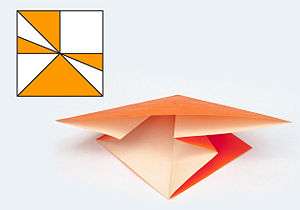Maekawa's theorem

Maekawa's theorem is a theorem in the mathematics of paper folding named after Jun Maekawa. It relates to flat-foldable origami crease patterns and states that at every vertex, the numbers of valley and mountain folds always differ by two in either direction.[1] The same result was also discovered by Jacques Justin.[2]
One consequence of Maekawa's theorem is that the total number of folds at each vertex must be an even number. This implies (via a form of planar graph duality between Eulerian graphs and bipartite graphs) that, for any flat-foldable crease pattern, it is always possible to color the regions between the creases with two colors, such that each crease separates regions of differing colors.[3] The same result can also be seen by considering which side of the sheet of paper is uppermost in each region of the folded shape.
See also
References
- ↑ Kasahara, K.; Takahama, T. (1987), Origami for the Connoisseur, New York: Japan Publications.
- ↑ Justin, J. (June 1986), "Mathematics of origami, part 9", British Origami: 28–30.
- ↑ Hull, Thomas (1994), "On the mathematics of flat origamis" (PDF), Proceedings of the Twenty-fifth Southeastern International Conference on Combinatorics, Graph Theory and Computing (Boca Raton, FL, 1994), Congressus Numerantium 100, pp. 215–224, MR 1382321. See in particular Theorem 3.1 and Corollary 3.2.